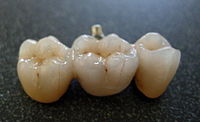
Photo from wikipedia
BACKGROUND It is currently unclear if a low insertion torque (IT) should prompt a clinician to submerge the dental implant at time of placement. PURPOSE This study aimed to analyze… Click to show full abstract
BACKGROUND It is currently unclear if a low insertion torque (IT) should prompt a clinician to submerge the dental implant at time of placement. PURPOSE This study aimed to analyze implant failure rates and marginal bone loss (MBL) as a function of IT and surgical approach. MATERIALS AND METHODS A total of 197 patients who had received 295 Mozo Grau (MG) implants were included in this study. The healing of submerged or nonsubmerged implants was evaluated in regular IT (≥20-25 Ncm) or low IT (<20-25 Ncm) cases. Implant failure and MBL were evaluated before prosthesis placement and at 6 and 12 months after functional loading with generalized estimating equations. RESULTS The overall 12-month implant failure rate was 4.8% (95% confidence interval [CI]: 2.7%-8.2%). When successful at 12 months, dental implants placed with low IT and nonsubmerging had the same MBL as implants dental implants placed with other approaches (mean difference = -0.02 mm; 95% CI -0.05 to 0.02). Low IT combined with nonsubmerging of the dental implant was associated with a 30-fold increased odds for dental implant failure (95% CI: 3.8-236.6). CONCLUSION low IT and nonsubmerged healing was associated with a high failure rate.
Journal Title: Clinical implant dentistry and related research
Year Published: 2022
Link to full text (if available)
Share on Social Media: Sign Up to like & get
recommendations!